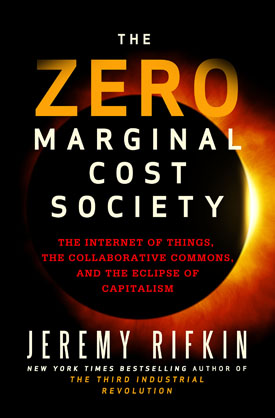
The connected economy that Jeremy Rifkin describes in The Zero Marginal Cost Society rests on a foundation of broadband communications networks. Yet those networks, paradoxically, may be some of the strongest hold-outs from the changes he describes. Without the right policy decisions, Rifkin's vision of sustained innovation and value creation through the collaborative commons is far from guaranteed.
Somehow, connectivity is becoming both cheaper and more expensive at the same time. The price of Internet transit -- moving bits across the backbone networks that make up the Internet -- has fallen by a factor of roughly 100 over the past decade. And a majority of wireless data traffic now runs through WiFi access points that use freely-shared "unlicensed" spectrum. So why do most users pay more today for their Internet access than ever? Virtually all mobile phone subscribers still pay significant monthly fees to carriers, and most now have usage caps on their data plans. What's going on?
Communications infrastructure creates an inherent business paradox. The marginal cost of connectivity is virtually zero, but the up-front expenses of building high-speed broadband networks are massive. Companies such as AT&T, Verizon, and Comcast invest many billions of dollars every year in capital expenditures. Even as an increasing share of economic activity builds on the virtually non-existent marginal cost of connectivity, these providers quite rationally build their business models around the stubbornly large fixed costs. End-user pricing is a function of their past investments, not the present costs of delivering bits. And those same high fixed costs limit the likelihood of competition as a countervailing factor, at least without significant regulatory involvement.
The point is not, as some suggest, that all network operators are dumb or greedy. Today's survivors in that market are, for the most part, well-managed companies striving for innovation and value-creation. They simply have different economics than the firms operating on top of the network. Given their fixed-cost focus, it's understandable they hesitate to invest without strong prospects of a return.
Yet this creates a huge challenge: The innovations that Rifkin describes depend upon bits being priced on something like a marginal basis. Moreover, operators focused on the fixed costs of bandwidth do not just set higher prices; they push for arrangements to differentiate and meter traffic, so those who get more value from the network also pay more. Witness recent efforts to impose usage caps on broadband subscribers and simultaneously charge content providers on the other end of the pipe. This dynamic threatens to eat into the latent surplus that powers the zero-marginal cost economy.
The potential benefits of a world of cheap digital connectivity are titanic, both in economic and social terms. It's far from certain, however, that we'll get there along the current market and policy trajectory.
So, what is to be done? Regulators can invoke principles such as network neutrality to police the most innovation-killing practices, but drawing the right lines is politically, economically, and technically fraught. Even if such rules are successfully adopted, they only address part of the problem. Network operators still need incentives to invest, which ultimately must come from competitive pressures. Turning network operators back into public utilities is even more politically infeasible, and it would cut against network innovation and operational excellence. Municipally-owned networks should be a factor, as they are in many other countries. They have their own challenges, however, and can't replace the incumbents across the board.
As Rifkin points out in his book, unlicensed wireless devices point the way to another model. These devices can share spectrum through technical coordination, avoiding the need for either exclusive private property rights or heavy-handed government management. Rifkin highlights the early work of legal scholars such as myself, Yochai Benkler, and Eli Noam promoting such open wireless networks. As Benkler brilliantly articulated, this approach substitutes distributed investments by users for centralized capital expenditures by network operators, finally solving the fixed-cost conundrum.
Millions of WiFi access points have been deployed around the world, and billions of end-user devices with unlicensed WiFi and Bluetooth radios have been sold in recent years. The network operators who once dismissed unlicensed systems as doomed to a cacophony of interference are now some of the biggest investors in these technologies, spending billions on "carrier WiFi" gear. Various providers are deploying WiFi access points that automatically function as public or community hubs. And TV White Spaces, the "super-WiFi" technology that Rifkin mentions, is finally ready for widespread commercialization. If open wireless connectivity continues to grow, it might overcome the paradox of network infrastructure funding.
There's only one problem: This outcome requires policy decisions in the near future that are far from certain. If the U.S. Federal Communications Commission gives in to pressure to structure its upcoming "incentive auction" for reclaimed broadcast spectrum too heavily in favor of short-term auction revenues, TV White Spaces may be starved for capacity. And if those network operators deploying carrier WiFi turn the unlicensed commons into private walled gardens, that status quo of connectivity may be further entrenched. The FCC and other agencies have to decide just how strongly they care about unleashing an open wireless future.
So the question becomes, what's the value of the commons? Or more precisely, is more aggregate value created as connectivity becomes increasingly open and increasingly free? Rifkin reminds us this is not a choice between profit-seeking private actors and some collectivist sense of well-being. The road to the connected commons runs directly through the valley of capitalist dynamism. Even today's incumbent operators can and should participate in building a new collaborative network ecosystem. We will only get there, however, if we make the right choices.